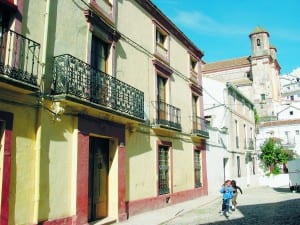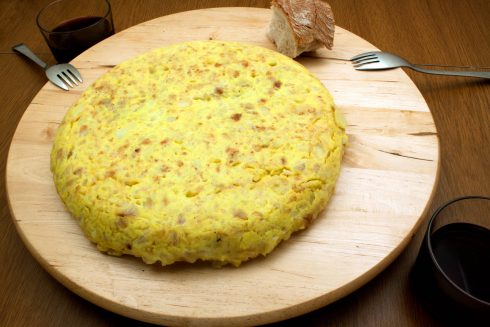By Jon Clarke
IT is only on weekends that it gets busy at Jesus and Rosa’s charming restaurant Casa Grande in Alpandeire.
Filling up with walkers and foodies, keen to try its celebrated local, organic dishes, it is a veritable hive of activity.
The rest of the time you can hear a pin drop in the village, which boasts just 300 hardy souls, a couple of donkeys and a doctor (well, once a week at least – but make sure to put your name on the list with plenty of time to spare).
But this is not your average whitewashed Andalucian village.
For starters, it is more or less square in shape, it has almost no expatriates and it counts on a church that is almost the size of a cathedral. Indeed, that is what the locals call it.
This is all thanks to one rather important Andalucian character. For it was here in the 1866 that a monk called Fray Leopoldo was born in the town.
A pious man, he is credited with a number of miracles and in 1961 the Vatican started the process of beautifying him and to this day disciples – mostly of the Capucin order – can be found visiting the village.
It is a charming spot, surrounded by breathtaking countryside with some of the best walks in Andalucia.
But there are few regions as evocative and unspoilt as the Genal Valley, where Alpandeire perches, surrounded by oak and chestnut trees.
Yet, as the crow flies, it is only ten miles from the concrete ribbon of the Costa del Sol… and 99.9 per cent of holidaymakers will not have heard of the little-visited area.
And more’s the shame, because the expansive valley that spreads over 42,000 hectares between the coast and Ronda, is a paradise for walkers, wildlife lovers and foodies.
Part of the Serrania de Ronda, this lovely collection of villages – 16 in total – are a joy to visit, each boasting their own local ventas and with a number of comfortable and decent hotels.

“It is hugely under visited for what it offers,” says hotelier David Nuyen, 49, who has been running the charming Hotel Bandolero, in the village of Juzcar, for six years.
“The nature here is unparalled and there are so many walks, most of them easy, between the various villages.”
There has even been a book dedicated specifically to the walks of the Valle del Genal. The only problem has been the signposting, which the regional authorities often fail to properly maintain.
But that is hopefully now changing, with the individual town halls going it alone to protect and promote their most precious resource.
“Our mayor has just put in some new signposts for a walk down to an old tin factory and abandoned village called Moclon,” says Nuyen. “And over in the neighbouring village of Farajan five new walks have recently been marked out.
“We have quite a few walking groups coming to stay. One couple walked nine different walks over nine days.”
This is completely understandable and on many weekends I head out for strolls with my family, normally taking in one of the many good restaurants, or sometimes packing a picnic.
A particularly nice time to visit is in late Autumn when the leaves of the valley’s predominantly chestnut (or castano) trees start turning a bright, burning red.
Said to have one of Europe’s cleanest rivers, the Genal is great to swim in
Earlier in September it is fun to take a walk and pick the numerous chestnuts that line the paths, before heading home to toast them on an open fire.
“Chesnuts are the only staple business here,” says Diana Beach, owner of the appropriately named Hotel los Castanos, in Cartajima. “Everybody is out picking in September and every family has their trees.”
In total, there are four different varieties of chestnut tree, some of them up to 500 years old.
Each local village picks them and sells them to a local cooperative that markets them around Spain and abroad.
“The locals also make plenty of local sweet things and put them in brandy,” says Beach. “They also roast them on a barbecue, called a ‘toston’.”
The only other industry in the valley involves the production of artesanal products, such as baskets, cork stools and blinds.
The latter – along with baskets and mats – are usually woven out of a plant, known as esparto, which is found on the high peaks, known as the ‘riscos’ above the valley.
Making beautiful blinds, which can be seen on many traditional houses in Ronda, and further afield in Sevilla, they are usually made to order and are not cheap.
The method is also slowly dying out, with few people left with the knowledge and skills to make them.
“A few decades ago esparto was a good living, but nowadays young people are not interested in learning the trade,” says Ana Martinez, whose shop El Quejigo, in Algotocin, sells the products, alongside local hams and cheeses.

“It is a lot of work and takes a long time and people just don’t have the patience,” she adds.
This is perhaps understandable given my experience of buying a trio of the charming woven blinds from a elderly woman who made them at her home in Igualeja a few years ago.
After ordering them in June in a bid to keep out the summer heat – taking over the exact measurements and paying a deposit – the sweet old lady told us we should return four months later in October. They looked great, but didn’t serve their purpose until the following summer.
Without a doubt, the Genal Valley’s main future will be tourism, with plans to open up the area with better roads and infrastructure.
Said to have one of Europe’s cleanest rivers, the Genal, there are plenty of places to swim in the river and some amazing places to stay, perhaps even buy.
As estate agent Mary Becker explains: “There are some lovely fincas in the unspoilt valley, with its small tracks leading to small hamlets.
“A lot of these farms and cottages are amazingly private and hidden from the world and you can find things from 35,000 euros to three million.
“But whatever you buy there you won’t regret it.”







